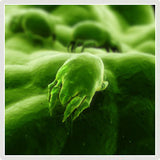 Thousands of microscopic dust mites probably live in your home, feeding on dead skin cells regularly shed from humans and pets. Although harmless to most people, they can cause allergic reactions in people with asthma or allergies.
Thousands of microscopic dust mites probably live in your home, feeding on dead skin cells regularly shed from humans and pets. Although harmless to most people, they can cause allergic reactions in people with asthma or allergies.
What are Dust Mites?
House dust mites are microscope bugs that primarily live on dead skin cells regularly shed from humans and their animal pets. Dust mites are harmless to most people. They don’t carry diseases, but they can cause allergic reactions in asthmatics and others who are allergic to their feces.
Skin cells and scales, commonly called dander, are often concentrated in lounging areas, mattresses, frequently used furniture and associated carpeted areas, and often harbor large numbers of these microscopic mites. Since the average human sloughs off 1/3 ounce (10 grams) of dead skin a week, that gives dust mites a lot to eat. Cats and dogs create far more dander for dust mites to eat.
A typical mattress can contain tens of thousands of dust mites. Sick yet? Nearly 100,000 mites can live in one square yard of carpet. Ready to convince your spouse to start bathing regularly? Did you know a single dust mite produces about 20 waste droppings each day, each containing a protein to which many people are allergic? Yuck! The proteins in that combination of feces and shed skin are what cause allergic reactions in humans. Depending on the person and exposure, reactions can range from itchy eyes to asthma attacks. And finally, unlike other types of mites, house dust mites are not parasites, since they only eat dead tissue. Gross, but true.
| Common Name | Scientific Name |
| North American House Dust Mite | Dermatophagoides farinae Hughes |
| European House Dust Mite | Dermatophagoides pteronyssinus (Trouessart) |
Where do they live?
Beds are a prime habitat (where 1/3 of life occurs). A typical used mattress may have anywhere from 100,000 to 10 million mites inside. (Ten percent of the weight of a two year old pillow can be composed of dead mites and their droppings.) Mites prefer warm, moist surroundings such as the inside of a mattress when someone is on it. A favorite food is dander (both human and animal skin flakes). Humans shed about 1/5 ounce of dander (dead skin) each week. About 80 percent of the material seen floating in a sunbeam is actually skin flakes. Also, bedroom carpeting and household upholstery support high mite populations.
The University of Manchester performed a 2005 medical study of pillows that found up to 16 species of fungi in a single pillow. They tested feather and synthetic pillows in a range of ages, finding thousands of spores of fungus per gram of pillow, more than is found on an average used toothbrush.
Are they harmful? What do they do?
For most people, while they are disgusting, house dust mites are not actually harmful. However, the medical significance of house dust mites arises because their microscopic cast skins and feces are a major constituent of house dust that induces allergic reactions in some individuals. There is a genetic predisposition to dust mite allergies, but like many allergies it can also develop over time.
One of the most strongly allergenic materials found indoors is house dust, often heavily contaminated with the fecal pellets and cast skins of House Dust Mites. Estimates are that dust mites may be a triggering factor for 50 to 80 percent of asthmatics, as well as in countless cases of eczema, hay fever and other allergic ailments. Common causes of allergy include house dust mites, cat dander, cockroach droppings and grass pollen. Symptoms are usually respiratory in nature (sneezing, itching, watery eyes, wheezing, etc.), usually not a rash. However, there are reports of a red rash around the neck. Other allergic reactions may include headaches, fatigue and depression.
The wheeze-inducing proteins are digestive juices from the mite gut which are quite potent. An exposure to the mites in the first, crucial year of life can trigger a lifelong allergy. There is no cure, only prevention. One must control house dust mite levels.
Source: http://www.ehso.com/ehshome/dustmites.php
View Top 10 Air Purifiers for Dust Browse All Air Purifiers for Dust

 Thousands of microscopic dust mites probably live in your home, feeding on dead skin cells regularly shed from humans and pets. Although harmless to most people, they can cause allergic reactions in people with asthma or allergies.
Thousands of microscopic dust mites probably live in your home, feeding on dead skin cells regularly shed from humans and pets. Although harmless to most people, they can cause allergic reactions in people with asthma or allergies.